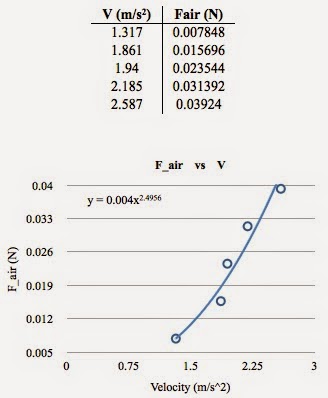Purpose
In this lab, we will find the relationship between resistance force and speed using coffee filters and creating a model of f_air of a falling object.
Procedure + Equipment
What we used:- coffee filters
- we dropped the coffee filters from a height and using logger pro, we were able to take a video and later analyze.
- meter stick
- the meter stick was used to provide a reference for how fast the coffee filter was falling
- logger pro
- using logger pro, the videos were analyzed to give us the velocity of the falling coffee filters
- One person dropped one coffee filter from a height while someone else held the meter stick for reference. Another person was using logger pro and recorded a video as the coffee filter fell.
- Step one was repeated with an additional coffee filter until a total of five coffee filters were dropped.
Part 1: Data + Analysis
 |
| This is the video analysis on logger pro. |
 |
| Video analysis for 1 filter |
 | |||
| Video analysis for 2 filters |
 |
| Video analysis for 3 filters |
 |
| Video analysis for 4 filters |
 |
| Video analysis for 5 filters |
From the video analysis, we are given a time vs distance graph, but what is relevant are the slopes of the equation from each graph, which are the velocities of the coffee filters as they fall down. Knowing the mass of the coffee filters we then determined the air resistance force (f_air), which is mass x gravity.
 | ||
| This helped in finding what air resistance force is, which is mg. |
 |
| These our values for air resistance force for each filter trial. |
With the velocity and f_air known, we were then able to create a graph using a power fit. With the graph, we were then able to take the equation of the power law fit, which is y = 0.004x^2.4956. This equation is similar to what f_air is: kv^n.
So, with our graph, we found the value for k = 0.004 and n = 2.4956.
 |
| This is the air resistance force vs velocity, which provides an equation of y = 0.004x^2.4956. The equation is similar to the equation F_resistance = kv^n, so our k is 0.004 and our n is 2.4956. |
Part 2: Data + Analysis
With our values of k and n we can create a model that shows the air resistance force of a falling object.
 |
| This data table is the modeling of f_air for a falling object. |
Summary
In this lab we used coffee filters to record a video as they fell. We were then able to get a time vs distance graphs from the videos we analyzed, and from the slopes we were able to get each velocity. From that data and the calculated f_air, a velocity vs f_air graph was created to help us find the relationship. We found the equation: y = 0.004x^2.4956 which is our relationship.So, we learned how to analysis a video on logger pro and found the relationship of a falling objects speed and air resistance force. We were also able to create a model of the falling objects from the values of k and n we found.
No comments:
Post a Comment